Electronegativity Study guides, Class notes & Summaries
Looking for the best study guides, study notes and summaries about Electronegativity? On this page you'll find 1215 study documents about Electronegativity.
Page 3 out of 1.215 results
Sort by
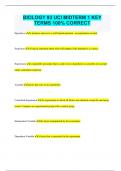
-
BIOLOGY 93 UCI MIDTERM 1 KEY TERMS 100% CORRECT
- Exam (elaborations) • 28 pages • 2024
- Available in package deal
-
- $9.99
- + learn more
BIOLOGY 93 UCI MIDTERM 1 KEY TERMS 100% CORRECT Hypothesis a tentative answer to a well framed question - an explanation on trial Prediction A logical statement about what will happen if the hypothesis is correct. Experiment a repeatable procedure that is used to test a hypothesis (a scientific test carried under controlled condition) Variable factors that vary in an experiment Controlled Experiment An experiment in which all factors are identical except the one being tested....
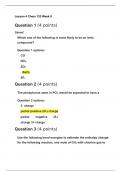
-
CHEM133 Week 9 Lesson 4 Quiz
- Exam (elaborations) • 12 pages • 2023
- Available in package deal
-
- $29.99
- + learn more
1. Question: Which one of the following is most likely to be an ionic compound? 2. Question: The phosphorus atom in PCl3 would be expected to have a 3. Question: The phosphorus atom in PCl3 would be expected to have a give CH3Cl and hydrogen chloride. 4. Question: How many of the following molecules have no dipole moment? 5. Question: Atoms having equal or nearly equal electronegativities are expected to form 6. Question: Element A has an electronegativity of 0.8 and element B has an electr...
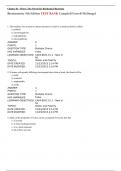
-
Biochemistry 9th Edition TEST BANK Campbell Farrell McDougal
- Exam (elaborations) • 40 pages • 2023
-
- $12.49
- + learn more
Biochemistry 9th Edition TEST BANK Campbell Farrell McDougal 1. The tendency for an atom to attract electrons to itself in a chemical bond is called a. polarity. b. electronegativity. c. hydrophilicity d. electrophilicity. 2. If atoms with greatly differing electronegativities form a bond, that bond will be a. polar. b. nonpolar. c. amphipathic. d. acidic. 3. Many of the properties of water can be accounted for by the...
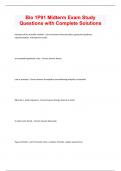
-
Bio 1P91 Midterm Exam Study Questions with Complete Solutions
- Exam (elaborations) • 53 pages • 2023
-
- $10.99
- + learn more
Bio 1P91 Midterm Exam Study Questions with Complete Solutions elements of the scientific method - Correct Answer characterization, generate hypothesis, experimentation, intemperate results an accepted hypothesis is aka - Correct Answer theory Law or principal - Correct Answer Accepted by overwhelming majority of scientists What do e- shells represent - Correct Answer Energy state of an atom In water ionic bonds - Correct Answer Dissociate Types of bonds - Correct Answer Ionic, co...
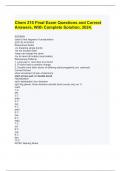
-
Chem 210 Final Exam Questions and Correct Answers, With Complete Solution, 2024.
- Exam (elaborations) • 12 pages • 2024
-
Available in package deal
-
- $11.99
- + learn more
Chem 210 Final Exam Questions and Correct Answers, With Complete Solution, 2024. SOPBAR used to find degrees of unsaturation ((2C+2)-H-X+N)/2 Resonance Rules -no breaking single bonds -do not exceed octet -keep net charge the same -try to have full octets (most stable) Resonance Patterns 1. Lone pair e- next door to pi bond 2. Pi bond next to positive charge 3. Double bond btwn atoms of differing electronegativity (ex: carbonyl) Curved Arrows show movement of pair of electrons s...
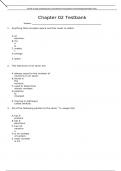
-
Test Bank for Foundations in Microbiology 8th Edition Talaro
- Exam (elaborations) • 183 pages • 2023
-
- $15.29
- + learn more
Chapter 02 Testbank Student: 1. Anything that occupies space and has mass is called A. an electron. B. livin g. C. matte r. D. energy . E. space . 2. The electrons of an atom are A. always equal to the number of neutrons in an atom. B. found in the nucleus. C. used to determine atomic number. D. positively charged. E. moving in pathways called orbitals. 3. All of the following pertain to the atom 146c except it(s) A. has 6 protons. B. has 6 electrons. ...
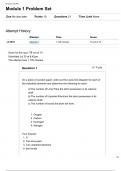
-
CHEM 219 Module 1 Problem Set Principles of Organic Chemistry with Lab Gallaher Portage Learning.
- Exam (elaborations) • 18 pages • 2024
- Available in package deal
-
- $11.99
- + learn more
CHEM 219 Module 1 Problem Set Principles of Organic Chemistry with Lab Gallaher Portage Learning. Score for this quiz: 10 out of 10 Submitted Jul 25 at 8:42pm This attempt took 1,135 minutes. Question 1 0 / 0 pts Your Answer: On a piece of scratch paper, write out the Lewis Dot Diagram for each of the indicated elements and determine the following for each: a) The number of Lone Pairs the atom possesses in its valence shell. b) The number of Unpaired Electrons the atom possesses in its...
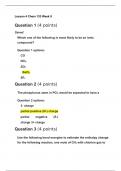
-
CHEM133 Week 9 Lesson 4 Quiz (All Correct)
- Exam (elaborations) • 12 pages • 2023
-
Available in package deal
-
- $25.48
- + learn more
1. Question: Which one of the following is most likely to be an ionic compound? 2. Question: The phosphorus atom in PCl3 would be expected to have a 3. Question: The phosphorus atom in PCl3 would be expected to have a give CH3Cl and hydrogen chloride. 4. Question: How many of the following molecules have no dipole moment? 5. Question: Atoms having equal or nearly equal electronegativities are expected to form 6. Question: Element A has an electronegativity of 0.8 and element B has an electr...
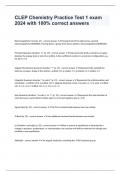
-
CLEP Chemistry Practice Test 1 exam 2024 with 100% correct answers
- Exam (elaborations) • 5 pages • 2024
-
- $16.49
- + learn more
Electronegativity trend (p. 21) - correct answer Moving from left to right across a period, electronegativity INCREASES. Moving down a group from top to bottom, electronegativity DECREASES. Principal Quantum Number: "n" (p. 19) - correct answer Represents the shell an electron occupies, denotes the energy level or size of an orbital. Is the coefficient number in an electron configuration e.g. for 3p^2, n=3 Angular Momentum Quantum Number: "l" (p. 19) - correct answer Represents the sub...

-
Solution Manual for Organic Chemistry 7th Edition by Brown All Chapters
- Exam (elaborations) • 37 pages • 2023
-
- $19.99
- + learn more
Solution Manual for Organic Chemistry 7th Edition by Brown CHAPTER 1 Solutions to the Problems Problem 1.1 Write and compare the ground-state electron configurations for each pair of elements: (a) Carbon and silicon C (6 electrons) 1s 2 2s 2 2p 2 Si (14 electrons) 1s 2 2s 2 2p 6 3s 2 3p 2 Both carbon and silicon have four electrons in their outermost (valence) shells. (b) Oxygen and sulfur O (8 electrons) 1s 2 2s 2 2p 4 S ...

Do you wonder why so many students wear nice clothes, have money to spare and enjoy tons of free time? Well, they sell on Stuvia! Imagine your study notes being downloaded a dozen times for $15 each. Every. Single. Day. Discover all about earning on Stuvia


